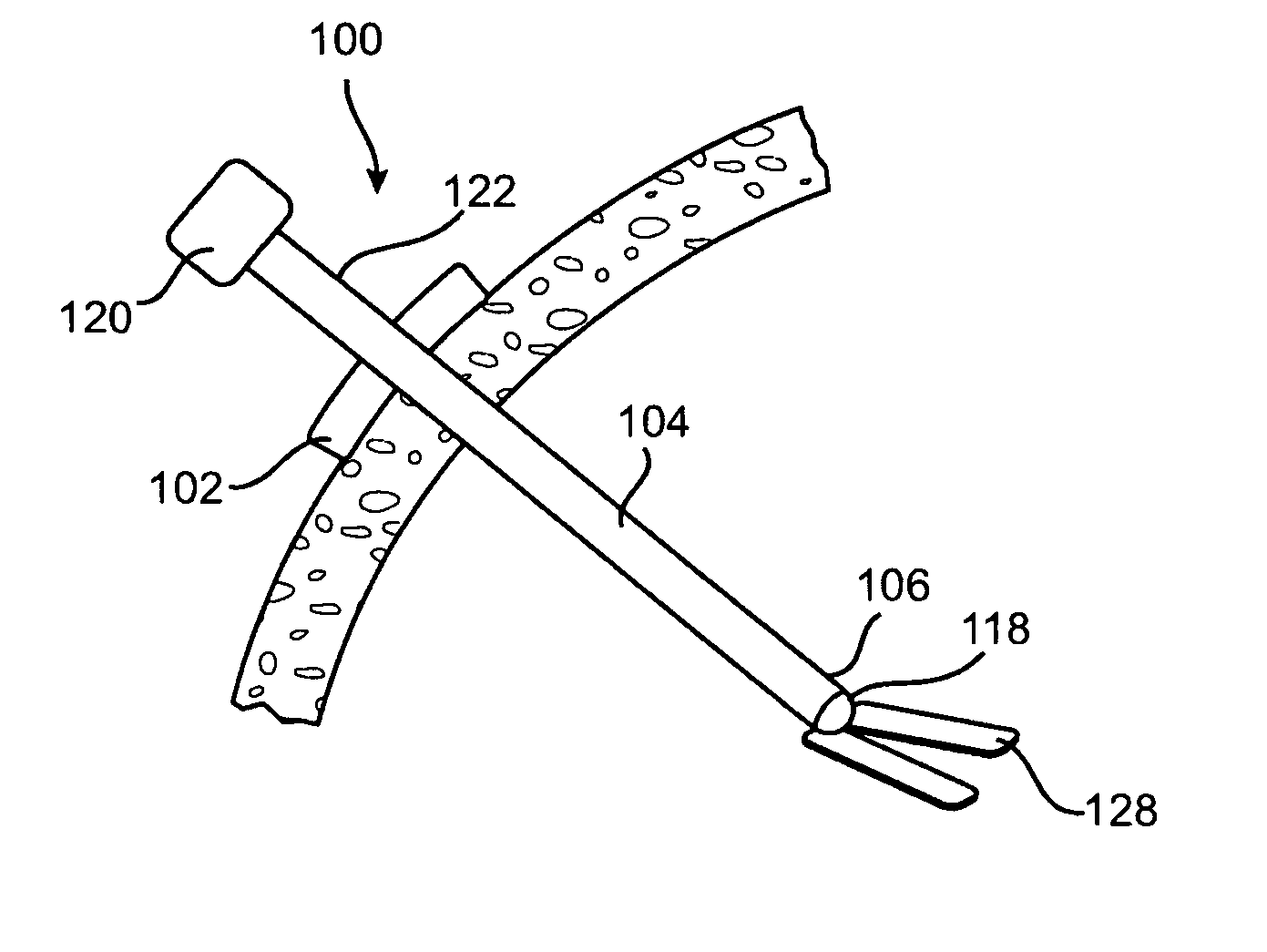Thorax mounted stabilization platform
a technology of a stabilization platform and a thorax, which is applied in the field of abdominal and thoracic surgical devices, can solve the problems of significant physical trauma to the patient, requiring one week of hospital recovery time, and weeks of convalescen
- Summary
- Abstract
- Description
- Claims
- Application Information
AI Technical Summary
Benefits of technology
Problems solved by technology
Method used
Image
Examples
first embodiment
[0016]FIG. 1 shows the stabilization platform 100. In this embodiment, an external stabilizer 102 is used to hold the platform in place during the surgical procedure being performed. The external stabilizer 102 is an object located around or attached to a rod 104 that prevents the distal end 106 of the rod from extending too far into the patient. The external stabilizer 102 may be located at a fixed point on the rod 104. Alternatively, the user may select a depth to which the end of the surgical instrument or rod 104 should extend and then move the external stabilizer 102 to the appropriate location along the rod 104. The rod 104 may have depth markers to assist in gauging the appropriate depth. Alternatively, the user may guide the distal end 106 of the rod 104 and / or surgical tool into place by feel or using a known imaging system. Then, the user would slide or place the external stabilizer 102 and affix it to the selected location on the rod 104. To further secure the external st...
second embodiment
[0017]FIG. 2 shows the stabilization platform. In this embodiment, an internal stabilizer 110 is used to hold the device in place during the surgical procedure being performed. The internal stabilizer 110 is an object located around or attached to the rod 104 that prevents the device from being inadvertently removed from the patient or may be used to seal the opening through the wall of the cavity in the patient.
[0018] The internal stabilizer 110 may take the form of an elongated member. The narrow direction of the internal stabilizer is sized to fit between the ribs of the patient. Once the internal stabilizer 110 is inserted into the patient, the internal stabilizer is rotated 90 degrees. The long direction of the internal stabilizer 110 is sized such that, after rotation, the ends of the elongated member 110 rest against the internal surface of the thoracic cavity.
[0019] In another version, the internal stabilizer is inflatable. Once the internal stabilizer has passed through th...
third embodiment
[0022]FIG. 3 shows the stabilization device 100. In this embodiment, both an external stabilizer 102, as described in FIG. 1, and an internal stabilizer 110, as described in FIG. 2, are used to hold the device in place during the surgical procedure being performed. With the use of both the internal and external stabilizers, the device is locked into place and cannot penetrate farther into the patient or move back out of the patient. In this version, the internal stabilizer and external stabilizer may be formed of one or more projections, which act as a clamp and may be selectively placed around a stable structure in the patient, such as a rib. If desired, two pair of projections may be used. In this case, the two pair can clamp onto two adjacent ribs. Additional pairs of projections may be used to further secure the device.
[0023] Alternate versions of the above embodiments may be configured with internal or external clamps to attach to other surgical tools, such as the retractor use...
PUM
 Login to View More
Login to View More Abstract
Description
Claims
Application Information
 Login to View More
Login to View More - R&D
- Intellectual Property
- Life Sciences
- Materials
- Tech Scout
- Unparalleled Data Quality
- Higher Quality Content
- 60% Fewer Hallucinations
Browse by: Latest US Patents, China's latest patents, Technical Efficacy Thesaurus, Application Domain, Technology Topic, Popular Technical Reports.
© 2025 PatSnap. All rights reserved.Legal|Privacy policy|Modern Slavery Act Transparency Statement|Sitemap|About US| Contact US: help@patsnap.com



